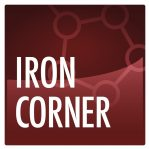
IV Iron Administration
Purpose
To assure the safe and appropriate administration of intravenous iron.

Population Covered
Infant, pediatric, adolescent, adult, and geriatric patients receiving intravenous iron.
Definition
Iron studies. Iron studies include ferritin, TIBC, serum iron, and percent transferrin saturation.
Supplemental Information
Indications
- Iron is critical for normal hemoglobin synthesis to maintain oxygen transport and myoglobin to facilitate oxygen transfer in muscles. Additionally, iron is necessary for cellular metabolism and synthesis of DNA and numerous enzymes.
- The total body iron content of an adult ranges from 2-4 grams. Assuming total body iron of 3,600 mg a typical distribution would be 2,200 mg as hemoglobin iron, 1,000 mg as ferritin and hemosiderin iron, 300 mg as myoglobin iron and 100 mg as iron in cytochromes and enzymes.
- The administration of exogenous erythropoietin increases red blood cell production and iron utilization. The increased iron may lead to absolute or functional iron deficiency with iron deficient erythropoiesis and a suboptimal response to exogenous erythropoietin.
- Iron deficiency is absolute when the hematologic indication of iron stores is low as determined by lab values such as ferritin, serum iron or transferrin saturation percent. Many consider a ferritin of less than 100 ng/mL to be consistent with decreased iron stores.
- Patients with functional iron deficiency do not meet laboratory criteria for absolute iron deficiency. However, when IV iron is administered, these patients will demonstrate an increase in hemoglobin/hematocrit or a dose reduction in erythropoietin with stable hemoglobin/hematocrit. These patients typically have a transferrin saturation less than 20%.
One should obtain baseline laboratory studies for hemoglobin, ferritin, serum iron and iron binding capacity, reticulocyte count and reticulocyte hemoglobin content if available. Reticulocyte hemoglobin content is a functional measure of iron status and can be of value before beginning iron therapy.
Iron supplements may be necessary when the following lab values are obtained:
- Ferritin less than 100 ng/mL and or
- Transferrin saturation less than 20%.
Note: Even if the absence of iron deficiency, intravenous iron is recommended in patients receiving exogenous erythropoietic stimulating agents (ESA).
Intravenous iron is indicated as a source of iron replacement in iron deficiency anemia if the patient:
- Cannot tolerate oral iron.
- Is considered unreliable to continue oral iron for an extended period of time.
- Has a malabsorption syndrome.
- Has an inflammatory process.
- Has kidney disease or heart failure.
- Is being treated with exogenous ESA.
- Has a need to rapidly replete iron stores.
- Has ongoing bleeding with associated iron losses greater than the patient’s capacity to absorb oral iron.
- Pregnancy during 2nd trimester if the Hb< 10.5g/dL, or in 3rd trimester when oral iron is unlikely to rapidly supply adequate iron to the developing fetus.
References
- Drug Therapy Topics. University of Washington Medical Center/Harborview Medical Center.
- Goodnough, L.T., Skikne, B., & Brugnara, C. (2000). Erythropoietin, iron and erythropoiesis. Blood, 96(3).
- Inpatient Pharmacy Guidelines. (2003). University Hospital of Arkansas, Arkansas.
- Davis, J., & Hader, R. (June 2001.) Erythropoietin and IV iron protocol for all patients except open heart, dialysis, and oncology.
- Center for Bloodless Care, Meridian Health System. Jersey Shore Medical Center, Neptune, New Jersey.
- Torres, S., Sorensen, E.R., Bliss-Holtz, J., & Neibart, R. (2001) Implication of iron in a transfusion alternative program (bloodless) in the cardiac surgery patient. Jersey Shore Medical Center, Neptune, New Jersey.
- Pavord S, Daru J, Prasannan N, Robinson S, Stanworth S, Girling J; BSH Committee. UK guidelines on the management of iron deficiency in pregnancy. Br J Haematol. 2020 Mar;188(6):819-830.
- Pasricha SR, Tye-Din J, Muckenthaler MU, Swinkels DW. Iron deficiency. 2020 Dec 4:S0140-6736(20)32594-0
 |